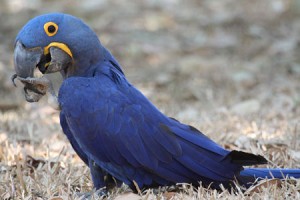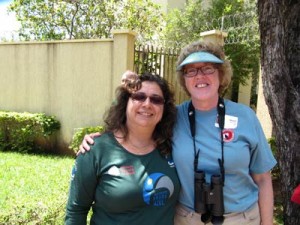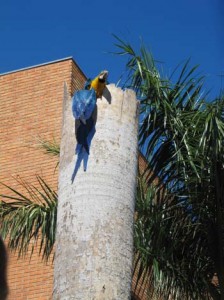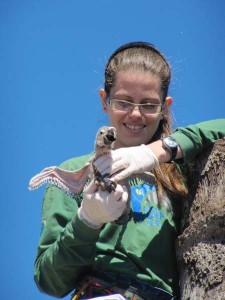Parrots of the Pantanal
 I recently returned from Brazil, where I visited the Pantanal region, the world’s largest tropical wetland and home to myriad species of parrots living in the wild. As an avian veterinarian, I had always wanted to see their natural behaviors. I had the good fortune to travel with a Phoenix Landing Eco tour of the Parrots of the Pantanal and see hyacinth macaws and other psittacines, and to meet incredible people helping to conserve and improve their populations. In this story, we learn about a powerhouse of a conservationist, Neiva Maria Robaldo Guedes, or Neiva as we called her.
I recently returned from Brazil, where I visited the Pantanal region, the world’s largest tropical wetland and home to myriad species of parrots living in the wild. As an avian veterinarian, I had always wanted to see their natural behaviors. I had the good fortune to travel with a Phoenix Landing Eco tour of the Parrots of the Pantanal and see hyacinth macaws and other psittacines, and to meet incredible people helping to conserve and improve their populations. In this story, we learn about a powerhouse of a conservationist, Neiva Maria Robaldo Guedes, or Neiva as we called her.

The Start Of It All
As a graduate student in wildlife many years ago, Neiva saw some hyacinth macaws in the area that she was working in the Pantanal region of Brazil. She asked her advisor about them; he told her they were very rare and most likely would become extinct in their native Brazil. She was captivated by the bird, the largest in the psittacine family, and decided to dedicate her life to bring them back. This one small but mighty person with singleness of purpose has done just that, struggling against all odds.
She initiated the project in 1990 in the south Pantanal to obtain information on the biology and ecology of the species. This information was then used to create management strategies. She was a one-man band, so to speak, for a while but was able to get her basic funding needs met through Toyota of Brazil and the World Wildlife Fund—Brazil.

Neiva monitored nesting sites, installed nest boxes when and where needed, watched and learned their reproductive behaviors, chick behavior, and chick survival rates. She also most importantly worked on ideas of ecotourism — without that, the group that I was associated with would not be standing in the midst of this one-woman giant saving the incredible hyacinth. Neiva has also helped other macaws and psittacine species. From those early days near the abyss, Neiva told us that there now approximately 6,500 hyacinths in the wild. What a remarkable feat.
Ongoing Efforts
Our group caught up with Neiva in Campo Grande about 555 miles west of São Paulo as the crow flies. She now has a small education center and several graduate students who are monitoring blue-and-gold macaw nest sites in the city. We followed the students with Neiva for part of the day. Several nests had eggs. There were several nest boxes, located in the heart of the city that had a healthy chick in them. One was next to an office building where, during the week, there were many people coming and going. It seemed that the macaws chose nesting sites near people and used dead palm trees where the tops were removed. Neiva believes that the blue-and-gold macaws have learned that the presence of people keep the predators away. Those predators include owls and the toco toucan, which likes to steal eggs and chicks with that long, colorful bill of theirs. The other problem is that the chicks can be susceptible to chilling and flooding of the nesting cavity with the rainy season. But these macaws have overcome these adversities and are thriving and producing chicks in the city.

It was so exciting to see these young blue-and-gold macaw chicks as the biologists pulled them for a brief period from their nests. At the nest site near an office building, there were two chicks that were only 1 and the second was about 3 days old. Near the central city, there was a single chick that was much larger. One of the biologists carefully brought the chick out of the nest to record measurements of its body size and weight. How remarkable that this chick was close to the public statue of hyacinth macaws erected to honor these magnificent birds!
Neiva’s influence has helped macaws not only to survive city life but to thrive in this city of 900,000. Additionally, she works with local leaders to help shape ecological zones in the city to keep wildlife a continued part of city life and to help ecotourism to flourish. This is a great testament to her influence and knowledge. It is also amazing that city planners are putting wildlife into the equation to make if better for them as well as humans!
It was an amazing time to learn about the hyacinth macaws and the spin off project of the blue-and gold macaws in Campo Grande. Nieva has learned first-hand about the biology of these macaws, from what they eat to their family relationships. She spent part of an evening giving us an overview of this information. All of it was fascinating and I will spend some time discussing some of her findings in a subsequent article. I will continue to write over the next few months about this amazing trip where I was able to watch and learn about the wild parrots of the Pantanal.
For more information, visit the Hyacinth Macaw Project website. Use your browser’s translation feature (often accessible via a right-click on pcs) to read it in English.
For more information about Phoenix Landing’s outreach programs for helping parrots at home and in the wild, see its website.





